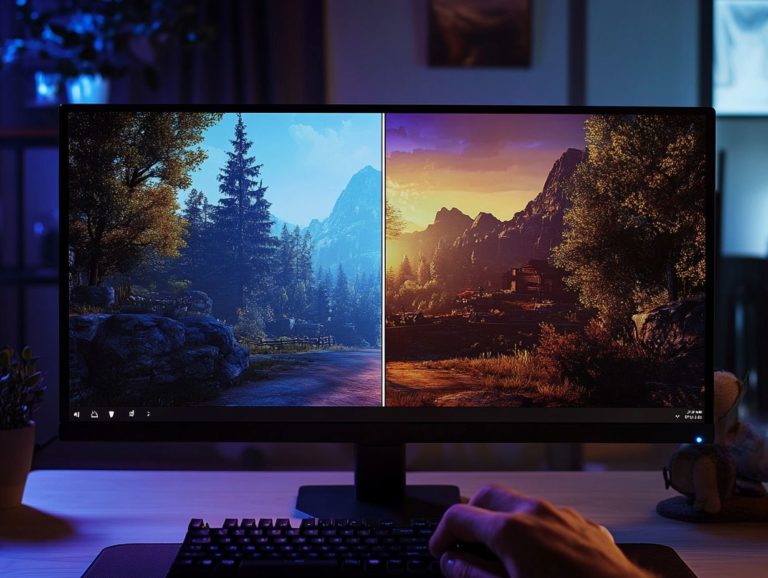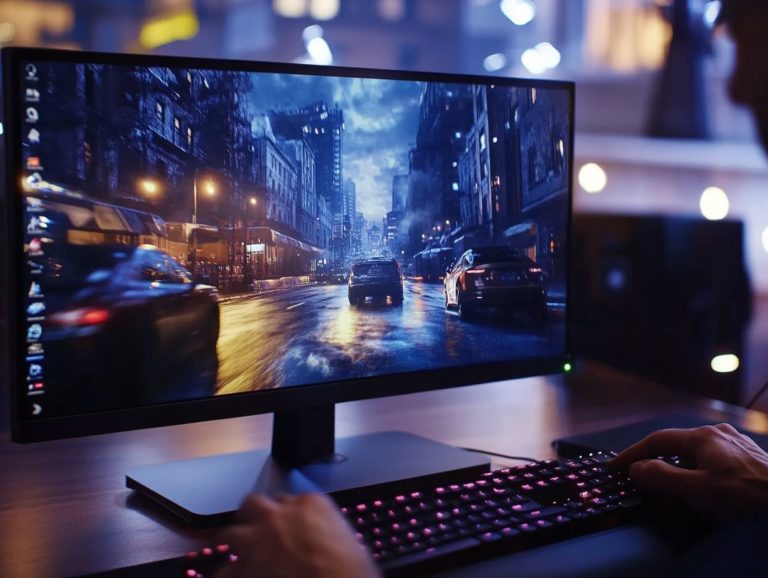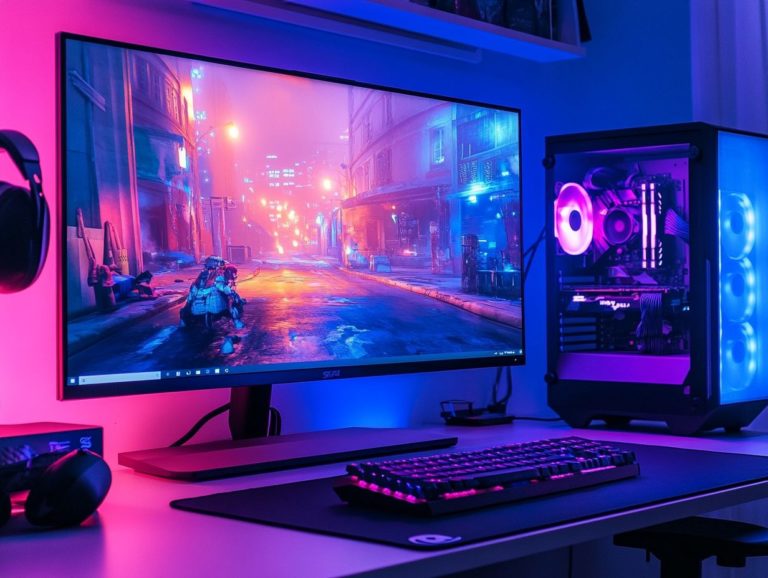the importance of color gamut in gaming
In the vibrant realm of gaming, the visual experience is paramount to immersing yourself fully in the action.
One key element that significantly influences this experience is the range of colors. Understanding what the range of colors is, the various types it encompasses, and its effect on graphics can profoundly transform your perception of your favorite games.
This piece delves into the intricacies of the range of colors, highlighting its significance in gaming, how it shapes your gameplay, and offering tips for selecting the ideal monitor to enhance your gaming adventure.
Prepare to elevate your gaming visuals to new heights!
Contents
Here s why color gamut matters in gaming:
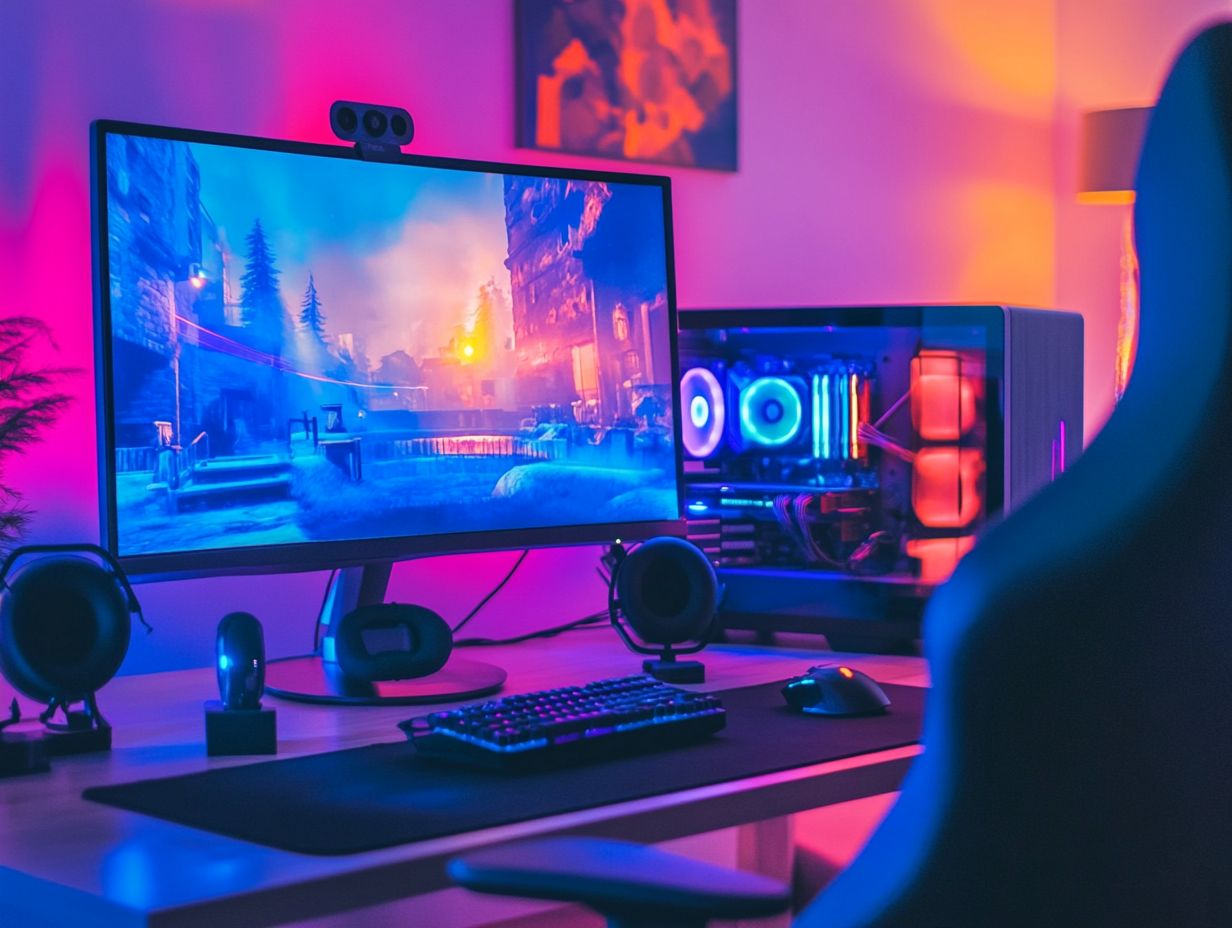
Color gamut is the range of colors that a monitor can display and is crucial in gaming for accurate and vibrant visuals.
There are different types of color gamut, including sRGB, Adobe RGB, and DCI-P3, each with its own capabilities and suitability for gaming.
When choosing a monitor for gaming, consider factors like color accuracy and vibrancy, as well as recommended monitors with optimal color gamut for gaming.
Understanding the Range of Colors in Gaming
Understanding the range of colors in gaming is essential for achieving unmatched visual quality and an immersive experience, especially when selecting gaming monitors that fit your specifications.
The range of colors defines the spectrum of colors a monitor can reproduce, significantly impacting the accuracy and vibrancy of colors in video games and other digital content.
Technology is evolving, and the necessity of selecting a monitor with the right range of colors only grows, catering to both casual gamers and video professionals who depend on precise colors and stunning visuals.
What is the Range of Colors?
The range of colors refers to the specific set of colors that your display device, like a gaming monitor, can reproduce. This is often illustrated on a diagram that shows different colors displayed by a monitor, helping define various color standards like sRGB, Adobe RGB, and DCI-P3.
You can quantify this range by measuring the color space, which determines how accurately colors are represented in different applications.
- For example, the sRGB color space is typically used for standard web content.
- Adobe RGB offers a wider gamut favored by graphic designers for print media.
- Meanwhile, DCI-P3 is gaining traction in cinematic applications, particularly for HDR gaming, where richer, more dynamic colors significantly enhance your visual experience.
Understanding these distinctions gives you the power to select the right display technology tailored to your needs, whether you’re engaged in professional design work or diving into immersive gaming adventures.
Why is it Important in Gaming?
The range of colors is a game changer in the world of gaming, as it directly impacts color accuracy and vibrancy, creating an immersive experience that enhances visual quality and overall gameplay especially in games rich in intricate designs and stunning graphics.
When you encounter those rich, true-to-life colors, your emotional engagement deepens, allowing you to connect more profoundly with the game s narrative and environments. This attention to detail is even more critical in professional gaming, where every nuance counts; a wider color range can highlight essential in-game elements, enabling you to make quicker, more informed decisions.
Even casual gamers stand to gain from these enhanced visual experiences. Brighter, more accurate colors can transform your enjoyment of a title, letting you truly appreciate the artistry behind character designs and landscapes.
Ultimately, the color space of a game elevates not just its aesthetic appeal but also cultivates a more compelling and immersive gaming atmosphere.
Types of Color Gamut
You ll find a variety of color gamuts across different monitors, with sRGB, Adobe RGB, and DCI-P3 reigning as the leading color standards.
Each of these gamuts defines the spectrum of colors achievable in today s gaming monitors, catering to a range of needs from casual gaming experiences to professional content creation.
Don’t miss out on the chance to upgrade your gaming visuals!
sRGB, Adobe RGB, and DCI-P3
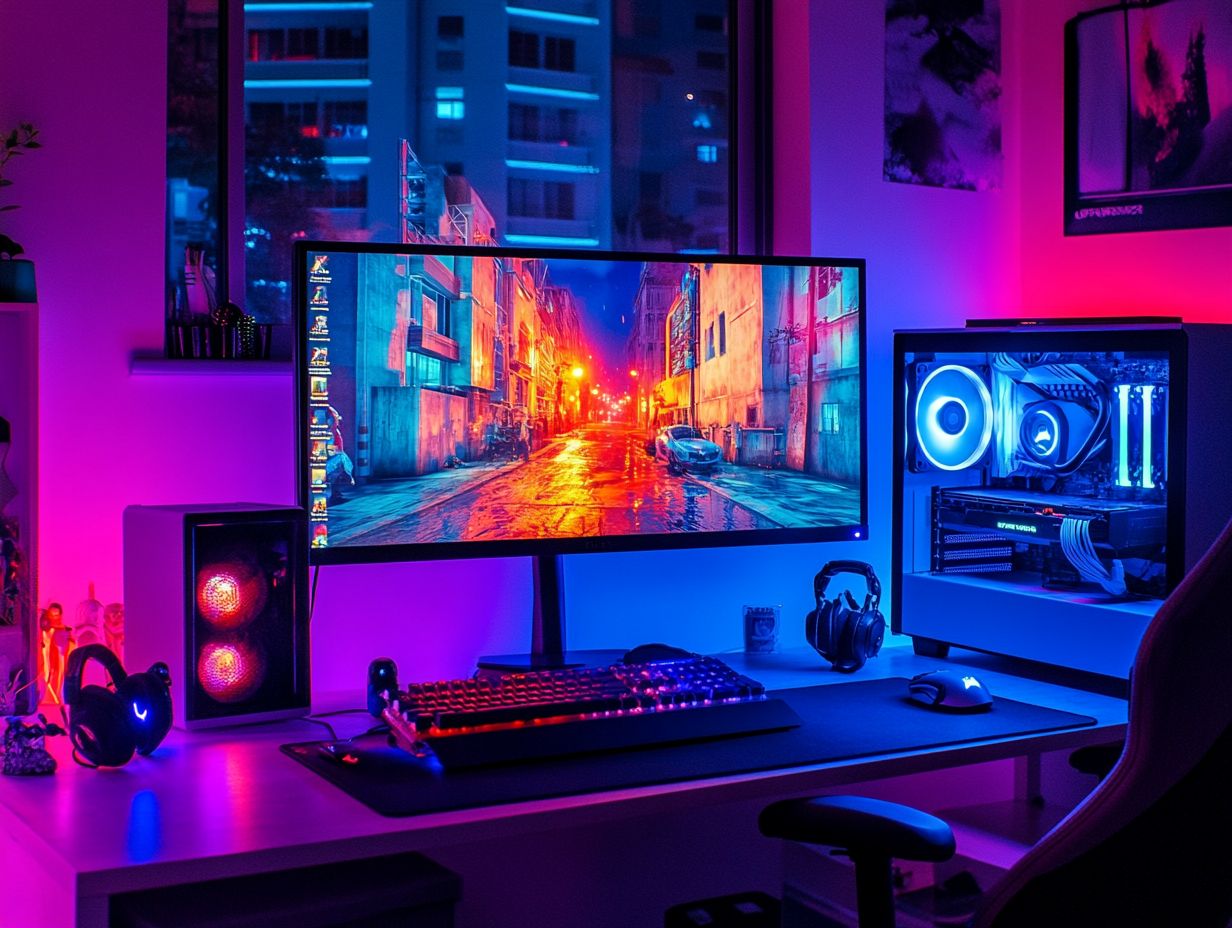
sRGB, Adobe RGB, and DCI-P3 are the three primary color gamuts to consider when selecting a monitor. Each serves distinct purposes.
sRGB is the go-to standard for most consumer displays. Adobe RGB and DCI-P3 excel in professional areas like color grading and content creation.
Each gamut has unique strengths. sRGB is well-suited for web graphics, ensuring consistent colors across devices.
Adobe RGB expands your color range, perfect for photographers and designers seeking vibrant prints.
DCI-P3 is favored in film and gaming, enhancing visuals with richer colors. Understanding these differences helps you choose the right monitor for your needs.
How Color Gamut Affects Gaming Experience
Color gamut is crucial for an immersive gaming experience. It directly influences color accuracy and richness on display.
This impacts graphics and your overall engagement. While refresh rate and response time matter, a wider color gamut can significantly elevate your gameplay.
Color Accuracy and Vibrancy
Color accuracy and vibrancy are vital for gaming monitors. They ensure every color appears as intended, enhancing your immersive experience.
Investing in a monitor with great color reproduction unlocks a vibrant world. Features like High Dynamic Range (HDR) provide deeper blacks and brighter highlights.
These elements profoundly affect gameplay, helping you spot enemies or appreciate beautiful scenery. A monitor rich in color makes every gaming session more thrilling.
Impact on Graphics and Gameplay
The impact of color gamut on graphics is significant. It shapes your immersive experience in gaming worlds.
A game showcasing a wider color spectrum enhances scene vibrancy, pulling you deeper into its universe. High-quality visuals elevate both aesthetics and gameplay mechanics.
In competitive gaming, noticing subtle hue differences can offer a tactical edge. As developers innovate with HDR and DCI-P3, the link between visuals and gameplay becomes clearer.
Choosing the Right Monitor for Optimal Color Gamut
Selecting the perfect monitor requires understanding key factors. Screen quality, refresh rate, and response time are essential.
Carefully evaluate these elements to find a gaming monitor that enhances your viewing experience to its fullest potential.
Factors to Consider

When you’re in the market for a gaming monitor, there are several key factors you should consider: color gamut, refresh rate, response time, and screen resolution. Together, these elements significantly elevate your gaming experience.
Each aspect is vital for the best visuals and responsiveness in gameplay. A wider color gamut provides richer, more vibrant colors, allowing in-game environments to feel more lifelike.
The refresh rate, measured in hertz, determines how many frames per second your display can manage, which is crucial for smooth motion especially in those adrenaline-pumping action games. A lower response time reduces ghosting, ensuring that every action is rendered sharply on your screen.
High screen resolution offers crisp images, enhancing your visibility and giving you the power to strategize effectively during intense gaming sessions.
Recommended Monitors for Gaming
In terms of gaming monitors, you ll find that the top recommendations shine in color gamut coverage and a host of premium features, with reputable brands offering various models designed to enhance your gaming experience.
These monitors typically come equipped with advanced specifications tailored for gamers, such as high refresh rates and low response times. Brands like ASUS and Dell are renowned for their high-performance models that boast a wide color gamut, ensuring your visuals are immersive.
Acer’s Predator series stands out with integrated technology that effectively minimizes screen tearing, providing you with smoother gameplay. LG’s UltraGear line impresses with exceptional HDR support, amplifying brightness and contrast for a more dynamic display.
Each of these options offers unique advantages that can elevate both your competitive play and casual gaming sessions to new heights.
Calibrating Color Gamut for Better Gaming
Calibrating the color gamut to improve the gaming experience is crucial for achieving accurate color reproduction and elevating visual quality.
This ensures your gaming monitor displays colors exactly as intended, allowing you to immerse yourself completely in the experience.
Tools and Techniques for Calibration
Utilizing the right tools and techniques for calibration is essential for achieving optimal color accuracy in your gaming monitors, ultimately enhancing your overall gaming experience.
Among the various options available, calibration tools like color meters and light meters provide the precise measurements needed for adjusting your color settings easily.
Software tools such as DisplayCAL and CalMAN offer detailed profiling, ensuring you can replicate colors accurately, regardless of the lighting conditions.
These calibration techniques are vital for gamers who aim to enhance visual fidelity, especially in competitive environments where color distinction can significantly impact performance.
By employing these methods, you can immerse yourself in a richer, more engaging gaming experience, transforming every session into something visually stunning.
Tips for Maintaining Color Accuracy
Maintaining color accuracy in your gaming monitor is essential for an optimal gaming experience, requiring regular calibration and awareness of environmental factors that can impact visual quality.
- Invest in a reliable calibration tool and dedicate time every few weeks for adjustments.
- Pay attention to your room’s lighting conditions, as both natural and artificial light can alter how colors appear on the screen.
- Utilize curtains or blinds to reduce glare and design a dedicated gaming space to enhance visual consistency.
- Keep your monitor settings optimized and understand how ambient light affects screen performance.
This attention to detail creates an immersive atmosphere where color fidelity becomes a pivotal aspect of your gaming experience.
Start calibrating today to fully enjoy your gaming adventures!
Frequently Asked Questions
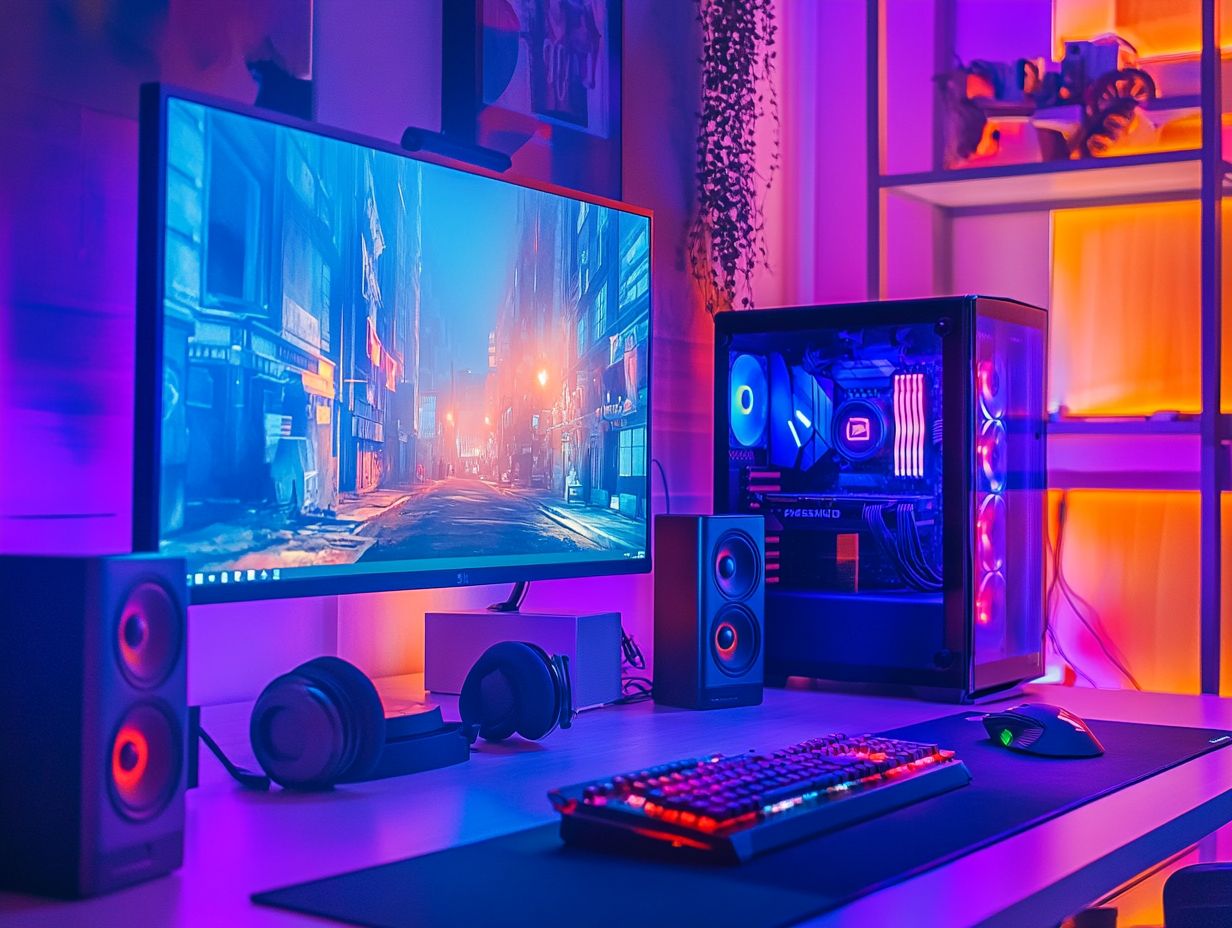
What is color gamut and why is it important in gaming?
Color gamut is the range of colors a device can display. In gaming, a wider color gamut means more vibrant and accurate colors, creating a more immersive experience.
How does color gamut affect visuals in gaming?
The wider the color gamut, the more colors can be displayed. This gives players visuals that are detailed and lifelike.
What are the types of color gamut in gaming?
The main types of color gamut are sRGB, Adobe RGB, and DCI-P3. DCI-P3 is preferred for gaming because it shows the largest range of colors.
How can I check the color gamut of my gaming device?
Check your gaming device’s specs for its color gamut. You can also use testing tools or compare it with devices that have known color gamuts.
What are the benefits of a wider color gamut in gaming?
A wider color gamut means more accurate and vibrant colors. This leads to a more realistic experience and enhances gameplay by making it easier to distinguish objects.
Can color gamut affect gaming performance?
Color gamut usually doesn’t impact performance directly. However, devices with wider gamuts might have higher resolution displays, which can influence performance. Consider the trade-off when choosing a gaming device.

